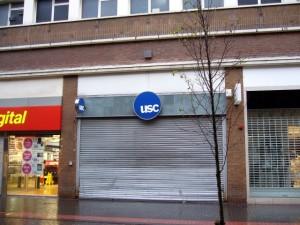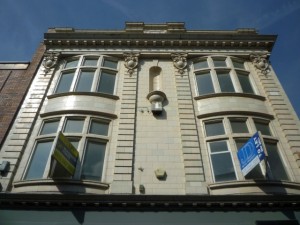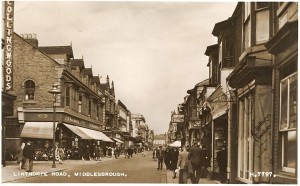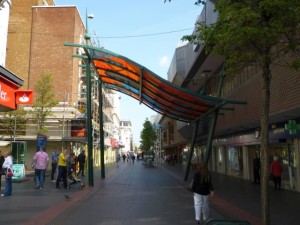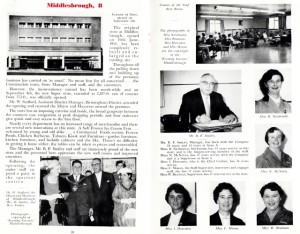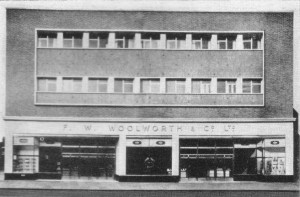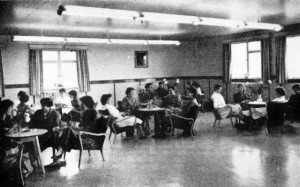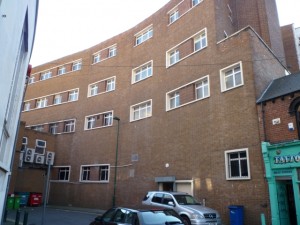
Last month I wrote about the former Woolworths store at 91-93 Linthorpe Road in Middlesbrough (store #8, below), which opened there in 1911. As I observed, it was not only the first Woolworths store in the town, but also had the distinction of being the first Woolworths in the North East.
I could also have noted that it was the first UK Woolworths to open outside either London or what we would today call the M62 corridor – certainly a piece of forgotten retail history of which Middlesbrough can be proud.
In this second post, however, it’s time to move on to look at Middlesbrough’s longest-lived Woolworths store at 51-67 Linthorpe Road.
2) Store #8 – 51-67 Linthorpe Road
As I noted last time, we know that Woolworths had vacated its original premises by the 1940s, and quite possibly sometime before, moving to a site further along the street towards the railway station (below). Because it was a straight move, the existing Woolworths store number – 8 – was simply transferred to the new premises.
Try to recapture the 1940s view today, and you’ll find very little in the way of continuity. The buildings on the right have been replaced by the rather overbearing structure of the Cleveland Centre (back to its original name, following its recent sale by The Mall Company), while the Woolworths premises were rebuilt in the 1950s – more of which in a moment. The main commonality between the two shots is the imposing white edifice housing Newhouse’s department store – today’s Debenhams – which is just visible in the far distance.
As happened in many other locations, such as Inverness or Leeds, Woolworths took the opportunity to rebuild and enlarge its Middlesbrough store in the 1950s, while – remarkably – managing to remain open for business throughout.
Usefully, the store’s official reopening on 4 September 1958, by the Mayor and Mayoress of Middlesbrough, formed the focus of an illustrated double-page spread in the December 1958 issue of The New Bond – the Woolworths ‘house journal’ that I’ve referred to on many previous occasions.
The piece provides some fascinating facts and figures about the new store, notably that its ‘counter run’ – still in the days before widespread self-service, remember – had been extended from 772 ft to 2,587 ft.
Detailing some of the other improvements, the article continues:
“The store has an imposing exterior and inside, the broad gangways between the counters ease congestion at peak shopping periods, and four staircases give quick and easy access to the first floor.”
It also highlights some of the new product ranges at the time, including what sounds like an early IKEA-style innovation in flat-pack furniture:
“Nearly every department has an increased range of merchandise and there are several new innovations at this store. A Soft Frozen Ice Cream Unit… welcomed by young and old alike… a Continental Foods section, Frozen Foods, Chicken Barbecue, Tobacco Kiosk and Furniture – garden furniture, kitchen furniture, and bedside cabinets and the like. There’s no difficulty in getting it home either, the tables can be taken to pieces and reassembled.
“The Manager, Mr. B. F. Smiley and staff are immensely proud of the new store and the personnel here appreciate the new staff rooms and improved amenities.”
By the 1980s, however, Woolworths had already withdrawn from many of those categories – including food – often leaving its city centre flagship stores with more space than they needed. The Middlesbrough store was among those that were closed down, with – as I noted previously – the building subsequently subdivided into smaller shop units.
Go around the back to the Newport Crescent side, however, and the building still looks much as it would have done when Woolworths was in occupation. The brick slab and strips of windows – also seen at Scarborough – still make it easy to recognise 50s and 60s Woolworths developments from the back or side.
For the first time in seventy-odd years, then, Middlesbrough town centre no longer had a branch of Woolworths – unlike other locations, such as Newcastle or Sheffield, which still had a second, smaller store that allowed Woolies to retain a presence in those locations.
As we’ll see in part 3, though, it wasn’t too long before a new – but much smaller – Woolworths opened up elsewhere in the town centre. That one’s presence, however, was to be rather more shortlived than its predecessors…
